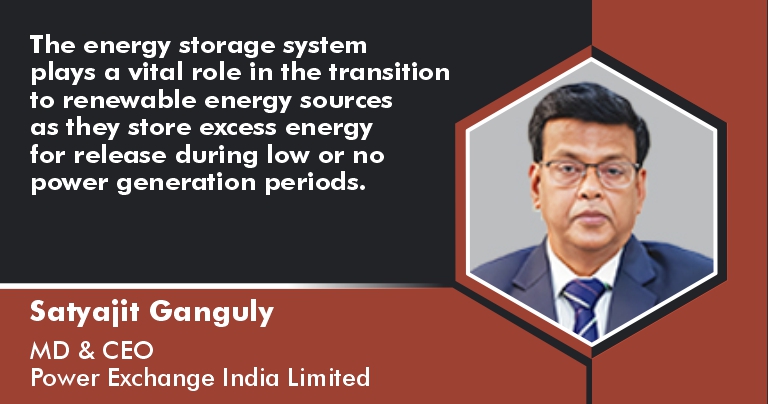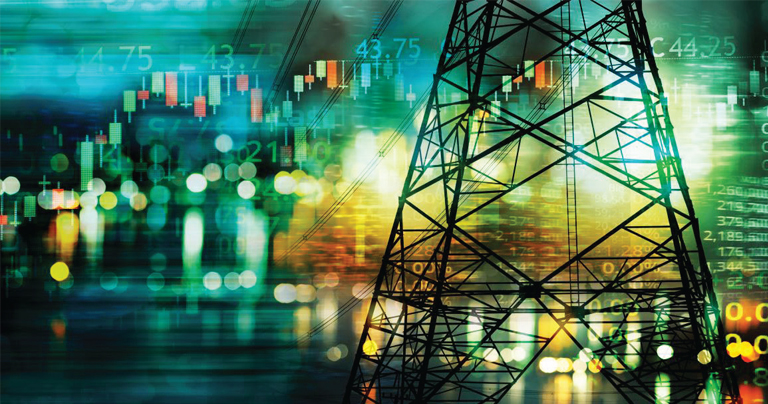India delves into the energy revolution through strategic investments
By EPR Magazine Editorial November 25, 2023 3:08 pm IST
By EPR Magazine Editorial November 25, 2023 3:08 pm IST

The energy storage system plays a vital role in the transition to renewable energy sources as they store excess energy for release during low or no power generation periods.
India stands at the forefront of a transformative era in its power sector, marked by impressive strides in renewable energy adoption. The nation aims to further enhance its energy infrastructure and sustainability with substantial investments and policy initiatives. Satyajit Ganguly analyses the prospects in a talk with EPR Magazine.
Investments and the workforce
Over the past decade, India’s power sector has had noteworthy achievements in terms of generation capacity addition and expanding the transmission and distribution network to meet consumers’ requirements. A key achievement is the country’s transition towards renewable energy, resulting in a significant increase in capacity and remarkably low tariffs on solar and wind energy. This shift towards renewable energy aligns with India’s ambitious target of achieving 500 GW of non-fossil capacity by 2030.
The government’s interventions have played a pivotal role in this transformation. Programmes such as 100 per cent electrification and the Ujwal Discom Assurance Yojana; amendments to the Electricity Conservation Act; the proposed Electricity (Amendment) Bill 2022; several progressive rules, regulations and guidelines in the form of GNA Regulations, market-based Ancillary Services, DSM Regulations and Grid Code 2023, and the Revamped Distribution Sector Scheme have had a profound impact on the sector’s growth.
The National Transmission Plan
It is to be appreciated that the gestation period of transmission infrastructure is nearly double that of solar plants, which generally attain commercial operation in 18 months. To tackle this, under the National Transmission Plan, the Ministry of Power has taken adequate steps to migrate into a regime of dynamic planning of the transmission system. Earlier, planning was done every five years with significant changes. However, it is reviewed every six months with significant emphasis on executing the network-level changes to remain co-terminus with envisaged additions in new generation capacity both in conventional and renewable space.
The gap between power supply and distribution
The administrative challenge of tariff revision delays in several states, vis-a-vis rising power purchase costs, has increased the disparity between the supply cost and the revenue generated. Discom’s precarious financial situation manifests in various issues, including their inability to remit timely payments to generation and transmission entities and a shortfall in investments for long-term infrastructure.
Under such a challenging scenario in the distribution segment, Discoms will have to harness advanced technologies diligently to address the technical and commercial inefficiencies within distribution networks. Discoms must adopt and implement analytical and data-driven strategies, supplemented by deploying smart technology to enhance power supply quality and dependability in their regions.
The demands of the digital era
The power sector is undergoing transformational changes, with analytics and digitalisation as key enablers to enhance operational efficiency and services to the consumer. Discoms must embrace digitalisation to reshape their business landscape and improve end-consumer services. Discoms of the future will be the one that demonstrates its ability to achieve single-digit losses, transform its infrastructure into a self-healing system, provide 24×7 reliable power to end-consumers, harness the power of data to provide personalised services to its consumers and meet the demand-supply gap dynamically by accessing the fair and transparent platform for power purchase.
Role of Energy Storage System
The critical role of the energy storage system plays a vital role in the transition to renewable energy sources as they store excess energy for release during periods of low or no power generation. In India, its adoption has been a measured response. The Government has consistently focused on policies to promote the renewable energy sector, aiming to achieve 500 GW of installed RE capacity by 2030. Last year, MOP introduced guidelines for the procurement and utilisation of BESS as part of the generation, transmission, and distribution of assets, along with ancillary services. Additionally, it notified the Energy Storage Obligations (ESO) of 1 percent in FY 2023-24, gradually rising to 4 percent by FY 2029-30.
A landmark moment for the Indian power sector
The passage of the Electricity Act of 2003, promoting competition, represented a landmark moment for the Indian power sector, and its effective implementation has attracted and nurtured public and private investment in transmission. Today, India has the fifth-largest power generation capacity in the world and is ranked third in electricity production.
Our Prime Minister’s recent motto of ‘One Sun, One World, One Grid’ has set the tone for a strong transmission system that supports India’s Renewable Energy growth and integrates it with renewables worldwide. The Ministry of Power constituted a task force comprising senior officials from CEA, PGCIL, GRID-INDIA, a few State utilities, and prominent educational institutions to prepare a roadmap for developing a modern and smart power transmission system. The task force report has identified important measures for real-time monitoring and automated operation of the grid, better situational assessment, capability to have an increased share of renewable capacity in the power mix, enhanced utilisation of transmission capacity, greater resilience against cyber-attacks as well as natural disasters, etc.
India is at a critical energy junction.
The Prime Minister of India has articulated focus areas for its energy economy, including a move towards a ‘gas-based economy,’ cleaner use of fossil fuels, rapidly scaling renewables, a shift towards emerging fuels, including hydrogen, and digital innovation across energy systems. The power sector needs to undertake two major transitions shortly to drive India’s growth through the coming years.
The first is the transition towards a more environmentally sustainable future with greater integration of renewable energy in the grid. The country will chart its path towards growth in renewables with heavy deployment of solar and wind in the coming decades. Wind and solar used in tandem yield zero carbon emissions and benefit the country. At the same time, the hour-to-hour variation in wind and solar output places increasingly large demands on the rest of the power system to balance supply and demand. With commercially feasible Battery Energy Storage Systems (BESS), Green Hydrogen, and a resurgence in hydro-pumped storage, the issue of renewable energy availability during evening and night hours can also be solved. This would require substantial investments and policy support to achieve scale over the next few years.
Spokesperson: Satyajit Ganguly- MD & CEO – Power Exchange India Limited
We use cookies to personalize your experience. By continuing to visit this website you agree to our Terms & Conditions, Privacy Policy and Cookie Policy.